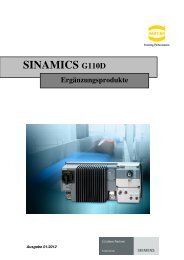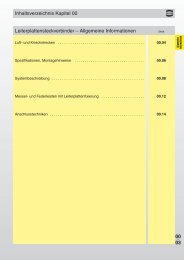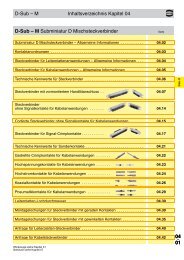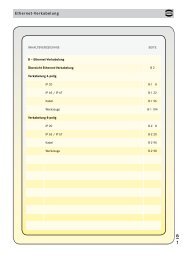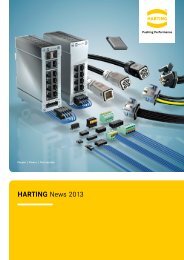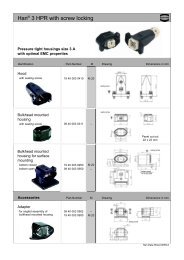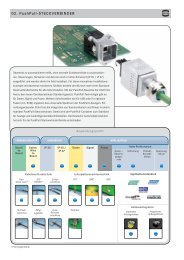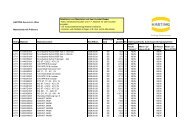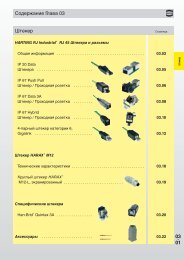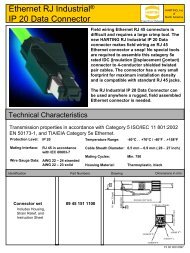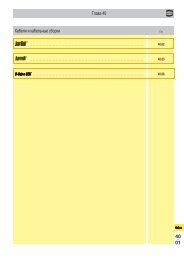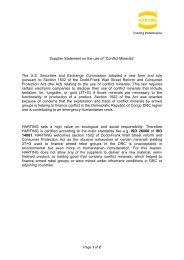Page 2 to 37
Page 2 to 37
Page 2 to 37
Create successful ePaper yourself
Turn your PDF publications into a flip-book with our unique Google optimized e-Paper software.
<strong>Page</strong> 2 <strong>to</strong> <strong>37</strong><br />
Report <strong>to</strong><br />
Qualification of a capable leadfree termination<br />
surface for wave soldering<br />
No.: F 28-05<br />
Table of contents<br />
<strong>Page</strong><br />
1. Definition of the specimen<br />
1.1 Contact stripes 3<br />
1.2 Connec<strong>to</strong>rs 3<br />
1.3 Printed Boards 4<br />
2. Preinvestigation of solderability by the wetting balance method.<br />
2.1 Test equipment 7<br />
2.2 Test schedule 8<br />
2.3 Results 9<br />
3. Qualification in the process at the cus<strong>to</strong>mer<br />
3.1 Overview of the test matrix 13<br />
3.2 Test schedule and acceptance criteria 14<br />
3.3 Backward compatibility<br />
3.3.1 Wave soldering process AP 16<br />
3.3.2 Wave soldering process BP 17<br />
3.3.3 Wave soldering process CP 18<br />
3.4 Forward compatibility<br />
3.4.1 Wave soldering process DP 26<br />
3.4.2 Wave soldering process EP 30<br />
3.4.3 Wave soldering process FP 35<br />
4 Summary <strong>37</strong><br />
Corporate Technology Services, HARTING KGaA, Marienwerderstraße 3, 32339 Espelkamp
<strong>Page</strong> 3 <strong>to</strong> <strong>37</strong><br />
Report <strong>to</strong><br />
Qualification of a capable leadfree termination<br />
surface for wave soldering<br />
No.: F 28-05<br />
1. Definition of the specimen<br />
1.1 Contact stripes<br />
Fig.1: BC male contacts<br />
1.2 Connec<strong>to</strong>rs<br />
Fig. 2,3 : DIN Type C male connec<strong>to</strong>r (HARTING Part.No.: 09031966921)<br />
Tin height<br />
Production parameters of the coating:<br />
Surface:<br />
Galvanic<br />
Plating thickness Sn:<br />
Plating thickness Ni:<br />
Base material :<br />
Matt Sn lead-free<br />
HARTING Electronics<br />
6,6µm (average)<br />
2,0µm (average)<br />
CuZn<strong>37</strong><br />
Corporate Technology Services, HARTING KGaA, Marienwerderstraße 3, 32339 Espelkamp
<strong>Page</strong> 4 <strong>to</strong> <strong>37</strong><br />
1.3 Printed boards<br />
Report <strong>to</strong><br />
Qualification of a capable leadfree termination<br />
surface for wave soldering<br />
No.: F 28-05<br />
Original cus<strong>to</strong>mer PCBs, in separate cases test PCBs, were used for the field trials.<br />
We express our gratitude <strong>to</strong>ward our cus<strong>to</strong>mers for their open and friendly support of our trials at their<br />
premises. To prevent an unauthorized circulation of sensitive or confidential cus<strong>to</strong>mers’ information,<br />
the field trials are recorded in a coded form in this test report. (AP – FP)<br />
The solder conditions are shown in detail for all separate field trials.<br />
Wave soldering test AP<br />
Fig. 4: Cus<strong>to</strong>mer PCB double euro size<br />
Board thickness:<br />
Diameter hole:<br />
Surface:<br />
1,6mm<br />
0,94mm –0,96mm<br />
Ni/Au<br />
Wave soldering test BP<br />
Fig. 5: Cus<strong>to</strong>mer PCB euro size<br />
Board thickness: 1,6mm<br />
Diameter hole: --<br />
Surface:<br />
HAL SnPb<br />
Corporate Technology Services, HARTING KGaA, Marienwerderstraße 3, 32339 Espelkamp
<strong>Page</strong> 5 <strong>to</strong> <strong>37</strong><br />
Report <strong>to</strong><br />
Qualification of a capable leadfree termination<br />
surface for wave soldering<br />
No.: F 28-05<br />
Wave soldering test CP 1<br />
Fig. 6: Cus<strong>to</strong>mer PCB euro size<br />
Board thickness: 1,6mm<br />
Diameter hole: --<br />
Surface:<br />
HAL SnPb<br />
Wave soldering test CP 2<br />
Fig. 7: Cus<strong>to</strong>mer PCB double euro size<br />
Board thickness:<br />
Diameter hole :<br />
Surface:<br />
1,6mm<br />
0,94mm –0,96mm<br />
Ni/Au<br />
Corporate Technology Services, HARTING KGaA, Marienwerderstraße 3, 32339 Espelkamp
<strong>Page</strong> 6 <strong>to</strong> <strong>37</strong><br />
Report <strong>to</strong><br />
Qualification of a capable leadfree termination<br />
surface for wave soldering<br />
No.: F 28-05<br />
Wave soldering test DP<br />
Fig. 8:Test PCB (HARTING) double euro size<br />
Type: HARTING leadfree test board 3 (manufactured 2005/01)<br />
Board thickness:<br />
Diameter hole :<br />
Surface:<br />
1,6mm<br />
0,97mm-0,99mm<br />
HAL Sn lead-free<br />
Chem. Sn<br />
Ni/Au<br />
Wave soldering test EP<br />
Fig. 9: Test PCB (HARTING) euro size<br />
Type: HARTING leadfree test board 3 (manufactured 2005/01)<br />
Board thickness: 1,6mm<br />
Diameter hole : 0,97mm-0,99mm<br />
Surface:<br />
HAL Sn leadfree<br />
Chem. Sn<br />
Ni/Au<br />
Wave soldering test FP<br />
Fig. 10: Cus<strong>to</strong>mer PCB, cus<strong>to</strong>m size<br />
Board thickness: 1,6mm<br />
Diameter hole : --<br />
Surface:<br />
Chem. Sn<br />
Corporate Technology Services, HARTING KGaA, Marienwerderstraße 3, 32339 Espelkamp
<strong>Page</strong> 7 <strong>to</strong> <strong>37</strong><br />
Report <strong>to</strong><br />
Qualification of a capable leadfree termination<br />
surface for wave soldering<br />
No.: F 28-05<br />
2. Preinvestigation of solderability by the wetting balance method<br />
2.1 Test equipment:<br />
Wetting balance test equipment HARTING ID: 532-060-11<br />
Solder:<br />
Stannol, Sn40Pb40, Sn95.5Ag3.8Cu0.7, Sn99.3Cu0.7<br />
Flux:<br />
Stannol Actiec 5 acc. <strong>to</strong> DIN EN 29453-1 class 1.1.2.A ( IEC class ROL1)<br />
Solid content: 0,125%<br />
Activity level : low<br />
Immersion time :<br />
Immersion speed:<br />
5sec<br />
20mm/sec<br />
Fig.: 11,12 : wetting balance test equipment<br />
Corporate Technology Services, HARTING KGaA, Marienwerderstraße 3, 32339 Espelkamp
<strong>Page</strong> 8 <strong>to</strong> <strong>37</strong><br />
2.2 Test schedule<br />
Report <strong>to</strong><br />
Qualification of a capable leadfree termination<br />
surface for wave soldering<br />
No.: F 28-05<br />
Reference document : in accordance <strong>to</strong> IEC 60068-2-20 (1979/1987) 4.5 Accelerated aging,<br />
IEC 60068-2-54 draft (2003) Solderability by wetting balance method.<br />
Test Requirement Reference-document Sample description<br />
S<strong>to</strong>rage<br />
room<br />
temperature<br />
20°C/60% r.h IEC 60068-2-20<br />
(1979/1987)<br />
dry heat 16h/155°C IEC 60068-2-20<br />
(1979/1987)<br />
steam aging 8h/96°C/100%r h IEC 60068-2-20<br />
(1979/1987)<br />
ANSI/EIA –364-52A<br />
(2003)<br />
Solderability by wetting balance method<br />
Solderability<br />
Solder<br />
Bath temperature<br />
Sn60Pb40 235°C<br />
Sn95,5 Ag3,8<br />
Cu0,7<br />
245°C<br />
Sn99,3 Cu0,7 250°C<br />
IEC 60068-2-54<br />
(draft 2003)<br />
contact stripes<br />
contact stripes<br />
contact stripes<br />
contact stripes<br />
Visual inspection<br />
Visual<br />
inspection<br />
Flux<br />
Actiec 5<br />
min 95% wetting IEC 60068-2-20<br />
(1979/1987)<br />
ANSI/EIA –364-52A<br />
(2003)<br />
contact stripes<br />
Corporate Technology Services, HARTING KGaA, Marienwerderstraße 3, 32339 Espelkamp
<strong>Page</strong> 9 <strong>to</strong> <strong>37</strong><br />
2.3 Results:<br />
Report <strong>to</strong><br />
Qualification of a capable leadfree termination<br />
surface for wave soldering<br />
No.: F 28-05<br />
Overview of the wetting results with the tested BC Male contact stripes (sample surface finish 17)<br />
Solder SnAgCu SnCu SnPb<br />
Flux Actiec 5 Actiec 5 Actiec 5<br />
unloaded ++ + ++<br />
after 16h/155°C dry heat ++ +o ++<br />
after 8h/96°C/100r.h<br />
steam aging<br />
o o o<br />
Definition of the acceptance criteria:<br />
++ = Wetting time < 0,5s / Wetting force = reference force<br />
+ = Wetting time < 1,0s / Wetting force = reference force<br />
+o = Wetting time < 1,5s / Wetting force min. 80% of the reference force<br />
o = Wetting time < 2,0s / Wetting force min. 80% of the reference force<br />
o- = Wetting time < 2,5s / Wetting force min. 50% of the reference force<br />
- = retarded Wetting time > 2,5s, bad Wetting force<br />
-- = retarded Wetting time > 2,5s, very bad Wetting force<br />
Some representative force-time curves:<br />
slow wetting very fast wetting wetting limited unstable wetting<br />
by thermal demand (dewetting)<br />
non wetting poor wetting good wetting retarded wetting<br />
Corporate Technology Services, HARTING KGaA, Marienwerderstraße 3, 32339 Espelkamp
<strong>Page</strong> 10 of <strong>37</strong><br />
Report <strong>to</strong><br />
Qualification of a suitable leadfree termination<br />
surface for wave soldering<br />
No.: F 28-05<br />
Contact stripes unloaded<br />
BC male contact stripes surface matt Sn; solder Sn95,5Ag3,8Cu0,7; Flux: Actiec 5<br />
Diagram 1:<br />
The force-time curve shows a good wetting (fast zero-crossing time (
<strong>Page</strong> 11 of <strong>37</strong><br />
Report <strong>to</strong><br />
Qualification of a suitable leadfree termination<br />
surface for wave soldering<br />
No.: F 28-05<br />
Contacts s<strong>to</strong>red 16h/155°C dry heat<br />
BC male contact stripes surface matt Sn; solder Sn95,5Ag3,8Cu0,7; Flux: Actiec 5<br />
Diagram 2:<br />
The force-time curve shows a good wetting (fast zero-crossing time (
<strong>Page</strong> 12 of <strong>37</strong><br />
Report <strong>to</strong><br />
Qualification of a suitable leadfree termination<br />
surface for wave soldering<br />
No.: F 28-05<br />
Contacts s<strong>to</strong>red 8h/96°C/100%rh steam aging<br />
BC male contact stripes surface Sn; solder Sn95,5Ag3,8Cu0,7; Flux: Actiec 5<br />
Diagram 3:<br />
The force-time curve shows a decelerated wetting, low wetting force.<br />
Fig. 17, 18: Good and complete wetting with no pores at the Sn surface, though the height of the<br />
solder wetting is smaller.<br />
Corporate Technology Services, HARTING KGaA, Marienwerderstraße 3, 32339 Espelkamp
<strong>Page</strong> 13 of <strong>37</strong><br />
Report <strong>to</strong><br />
Qualification of a suitable leadfree termination<br />
surface for wave soldering<br />
No.: F 28-05<br />
3. Qualification in the process at the cus<strong>to</strong>mer<br />
Field trials at the solder machines of various cus<strong>to</strong>mers of the market<br />
segments machine <strong>to</strong>ols, industrial communication and PCB assembly.<br />
Temperature profile<br />
On of the 4 (in <strong>to</strong>tal) tested<br />
PCBs<br />
One of the 5 (in <strong>to</strong>tal) tested solder<br />
facilities<br />
Evaluation of solder results acc. <strong>to</strong> IPC<br />
Corporate Technology Services, HARTING KGaA, Marienwerderstraße 3, 32339 Espelkamp
<strong>Page</strong> 14 of <strong>37</strong><br />
Report <strong>to</strong><br />
Qualification of a suitable leadfree termination<br />
surface for wave soldering<br />
No.: F 28-05<br />
3.2 Test schedule and acceptance criteria<br />
Reference document: IPC-A-610-D:2005; Part 5.1 Soldering acceptability requirements;<br />
Part 7.6 plated through holes with component leads.<br />
Test Requirement Reference document Sample description<br />
S<strong>to</strong>rage<br />
room<br />
temperature<br />
20°C/60% r.h IEC 60068-2-20<br />
(1979/1987)<br />
dry heat 16h/155°C IEC 60068-2-20<br />
(1979/1987)<br />
steam aging 8h/96°C/100%r h IEC 60068-2-20<br />
(1979/1987)<br />
ANSI/EIA –364-52A<br />
(2003)<br />
Process capability for Wave soldering<br />
DIN male connec<strong>to</strong>r<br />
Type C<br />
DIN male connec<strong>to</strong>r<br />
Type C<br />
DIN male connec<strong>to</strong>r<br />
Type C<br />
Test 1 AP Test 2 BP Test 3 CP Test 5 DP Test 4 EP Test 6 FP<br />
wave-solder machine<br />
type: SEHO System<br />
8530<br />
wave-solder machine<br />
type: SEHO System,<br />
2035<br />
wave-solder machine<br />
type: Ersa<br />
wave-solder machine<br />
type: EPM<br />
wave-solder machine<br />
type SEHO System<br />
2340<br />
wave-solder machine<br />
type: SEHO System<br />
2340<br />
solder: SnPb solder: SnPb solder: SnPb solder: SnCu solder: SnAgCu solder: SnAgCu<br />
double euro format<br />
Ni/Au<br />
Visual inspection<br />
visual inspection<br />
cross section<br />
euro format<br />
HAL SnPb<br />
acc. <strong>to</strong> IPC A610-D<br />
class 1,2,3<br />
Acc. <strong>to</strong> IPC A610-D<br />
class 1,2,3<br />
euro format<br />
HAL SnPb<br />
double Eurocard<br />
Ni/Au<br />
double euro format<br />
HAL Sn lead-free<br />
Chem. Sn<br />
Ni/Au<br />
IPC-A-610-D<br />
(2005)<br />
IPC-A-610-D<br />
(2005)<br />
double euro format<br />
HAL Sn lead-free<br />
Chem. Sn<br />
Ni/Au<br />
spezial format<br />
Chem. Sn<br />
soldered DIN male connec<strong>to</strong>r<br />
type C<br />
soldered DIN male connec<strong>to</strong>r<br />
type C<br />
Corporate Technology Services, HARTING KGaA, Marienwerderstraße 3, 32339 Espelkamp
<strong>Page</strong> 15 of <strong>37</strong><br />
Report <strong>to</strong><br />
Qualification of a suitable leadfree termination<br />
surface for wave soldering<br />
No.: F 28-05<br />
Acceptability requirements for solder joints with plated-through holes acc. <strong>to</strong><br />
IPC<br />
Criteria Class1 Class2 Class3<br />
A. Wetting on the primary side (solder destination side) Not specified 180° 270°<br />
of lead and barrel<br />
B. Vertical fill of solder Not specified 75% 75%<br />
C. Fillet and wetting on the secondary side (solder<br />
270° 270 330°<br />
source side) of lead and barrel<br />
D. Percent of land area covered with wetted solder on 0 0 0<br />
the primary side (solder destination side)<br />
E. Percent of land area covered with wetted solder on<br />
the secondary side (solder source side)<br />
75% 75% 75%<br />
Evaluation of solder joints with the help of a cross-section<br />
Fig. 19 & 20<br />
Target class 1-3 Acceptable class 1-3<br />
75%<br />
Anzustrebende<br />
Fig. 21 & 22<br />
Target for class 1-3 360° wetting on lead and barrel<br />
Corporate Technology Services, HARTING KGaA, Marienwerderstraße 3, 32339 Espelkamp
<strong>Page</strong> 16 of <strong>37</strong><br />
Report <strong>to</strong><br />
Qualification of a suitable leadfree termination<br />
surface for wave soldering<br />
No.: F 28-05<br />
3.3 Backward compabtiility<br />
3.3.1 Test 1AP:<br />
Wave soldering (SnPb) with PCB plating Ni/Au<br />
A wave solder machine with a double wave function (manufacturer: SEHO) was used<br />
for the trials. The machine is equipped with a spray flux dispension system and<br />
infrared heating modules. The pcb’s with preassembled components were mounted<br />
in<strong>to</strong> type-specific retaining frames which prevented the overflow of liquid solder on<strong>to</strong><br />
the components on the pcb and protected the connec<strong>to</strong>r mouldings from thermal<br />
stress.<br />
Fig. 23: wave solder machine SEHO system 8530 MPR<br />
Process parameters: Test 1 AP<br />
Wave solder machine SEHO system 8530 MPR<br />
Solder<br />
SnPb<strong>37</strong><br />
Flux<br />
Chemical circuit P880 (Halogen-free and resin-free, no clean,<br />
Solids content 1,9%<br />
Solder temperature 245°C<br />
Wave solder<br />
Atmosphere<br />
Speed<br />
Wave solder contact time<br />
only Chip-wave, 28mm high<br />
normal air<br />
120cm/min<br />
1-1,3s<br />
Corporate Technology Services, HARTING KGaA, Marienwerderstraße 3, 32339 Espelkamp
<strong>Page</strong> 17 of <strong>37</strong><br />
Report <strong>to</strong><br />
Qualification of a suitable leadfree termination<br />
surface for wave soldering<br />
No.: F 28-05<br />
Diagram 4: Temperature profile of the soldering program used. The thermocouple was mounted at the<br />
right angled termination on the secondary side of the PCB (no contact <strong>to</strong> the wave solder).<br />
Corporate Technology Services, HARTING KGaA, Marienwerderstraße 3, 32339 Espelkamp
<strong>Page</strong> 18 of <strong>37</strong><br />
Result: Test AP<br />
Report <strong>to</strong><br />
Qualification of a suitable leadfree termination<br />
surface for wave soldering<br />
No.: F 28-05<br />
The visual and microscope inspection shows that the requirements in accordance <strong>to</strong> the IPC<br />
norm IPC-A-610-D:2005; chapter 5.1 Soldering Acceptability Requirements; and chapter 7.6<br />
Plated Through Holes with Component Leads are fulfilled.<br />
Fig. 24: Soldered DIN C male connec<strong>to</strong>r secondary side<br />
Fig. 25: secondary side<br />
Fig. 26: primary side<br />
Fig. 27, 28: cross-section , good meniscus visible<br />
Corporate Technology Services, HARTING KGaA, Marienwerderstraße 3, 32339 Espelkamp
<strong>Page</strong> 19 of <strong>37</strong><br />
Report <strong>to</strong><br />
Qualification of a suitable leadfree termination<br />
surface for wave soldering<br />
No.: F 28-05<br />
3.3.2 Test BP:<br />
Wave soldering (SnPb with PCB plating HAL SnPb<br />
The wave solder machine SEHO System 2035 with a double wave function was used for the trials.<br />
The pcb’s with preassembled components were mounted in<strong>to</strong> type-specific retaining frames which<br />
prevented the overflow of liquid solder on<strong>to</strong> the components on the pcb and protected the connec<strong>to</strong>r<br />
mouldings from thermal stress.<br />
Process parameters<br />
Wave solder machine SEHO system 2035<br />
Solder<br />
SnPb<strong>37</strong><br />
Flux Home-made, Isopropanol/Adipinsäure (1,5%)<br />
Solder temperature 260°C<br />
Wave solder<br />
Atmosphere<br />
Speed<br />
Wave solder contact time<br />
main wave<br />
nitrogen<br />
120cm/min<br />
3,8 s<br />
Diagram 5: Temperature profile of used soldering program, only main wave used. Special trial pcb.<br />
The thermocouple (red curve) was mounted at the primary side of the pcb.<br />
Corporate Technology Services, HARTING KGaA, Marienwerderstraße 3, 32339 Espelkamp
<strong>Page</strong> 20 of <strong>37</strong><br />
Result. Test BP<br />
Report <strong>to</strong><br />
Qualification of a suitable leadfree termination<br />
surface for wave soldering<br />
No.: F 28-05<br />
The visual and microscope inspection shows that the requirements in accordance <strong>to</strong> the IPC<br />
norm IPC-A-610-D:2005; chapter 5.1 Soldering Acceptability Requirements; and chapter 7.6<br />
Plated Through Holes with Component Leads are fulfilled.<br />
Fig. 29: Soldered DIN C male connec<strong>to</strong>r secondary side<br />
Fig. 30: secondary side<br />
Fig. 31 primary side<br />
Fig. 32, 33 cross-section, good meniscus visible<br />
Corporate Technology Services, HARTING KGaA, Marienwerderstraße 3, 32339 Espelkamp
<strong>Page</strong> 21 of <strong>37</strong><br />
Report <strong>to</strong><br />
Qualification of a suitable leadfree termination<br />
surface for wave soldering<br />
No.: F 28-05<br />
3.3.3 Test CP:<br />
Wave soldering (SnPb) with PCB plating HAL SnPb und Ni/Au<br />
The wave solder machine ERSA with a double wave function was used for the trials. The pcb’s were<br />
mounted in<strong>to</strong> retaining frames and the connec<strong>to</strong>r mouldings were covered with heat protection caps.<br />
Fig. 34, 35 Printed board mounted in the retaining frame<br />
Corporate Technology Services, HARTING KGaA, Marienwerderstraße 3, 32339 Espelkamp
<strong>Page</strong> 22 of <strong>37</strong><br />
Report <strong>to</strong><br />
Qualification of a suitable leadfree termination<br />
surface for wave soldering<br />
No.: F 28-05<br />
Process parameters<br />
Wave solder machine ERSA<br />
Solder<br />
SnPb<strong>37</strong><br />
Flux Alphametals E193 (low activated )<br />
Solder temperature 245°C<br />
Wave solder<br />
Chip- und main wave<br />
Atmosphere<br />
nitrogen<br />
Speed<br />
100 cm/min<br />
Wave solder contact time 3,8 – 4,5s<br />
Diagram 6: Temperature profile of the used soldering program, recorded with a special trial PCB. The<br />
thermo sensors were mounted on the primary side of the PCB, see Pic. 65.<br />
Corporate Technology Services, HARTING KGaA, Marienwerderstraße 3, 32339 Espelkamp
<strong>Page</strong> 23 of <strong>37</strong><br />
Report <strong>to</strong><br />
Qualification of a suitable leadfree termination<br />
surface for wave soldering<br />
No.: F 28-05<br />
Diagram 7: Solder wetting profile<br />
Corporate Technology Services, HARTING KGaA, Marienwerderstraße 3, 32339 Espelkamp
<strong>Page</strong> 24 of <strong>37</strong><br />
Result Test CP<br />
Report <strong>to</strong><br />
Qualification of a suitable leadfree termination<br />
surface for wave soldering<br />
No.: F 28-05<br />
PCB plating: HAL SnPb<br />
The visual and microscope inspection shows that the requirements in accordance <strong>to</strong> the IPC<br />
norm IPC-A-610-D:2005; chapter 5.1 Soldering Acceptability Requirements; and chapter 7.6<br />
Plated Through Holes with Component Leads are fulfilled.<br />
Fig 36: Soldered DIN C male connec<strong>to</strong>r secondary side<br />
Fig. <strong>37</strong>: secondary side<br />
Fig. 38: primary side<br />
Fig. 39, 40: cross-section, good meniscus visible<br />
Corporate Technology Services, HARTING KGaA, Marienwerderstraße 3, 32339 Espelkamp
<strong>Page</strong> 25 of <strong>37</strong><br />
Report <strong>to</strong><br />
Qualification of a suitable leadfree termination<br />
surface for wave soldering<br />
No.: F 28-05<br />
PCB plating:<br />
Ni/Au<br />
The visual and microscope inspection shows that the requirements in accordance <strong>to</strong> the IPC<br />
norm IPC-A-610-D:2005; chapter 5.1 Soldering Acceptability Requirements; and chapter 7.6<br />
Plated Through Holes with Component Leads are fulfilled.<br />
Fig 41: Soldered DIN C male connec<strong>to</strong>r secondary side<br />
Fig. 42: secondary side<br />
Fig. 43: primary side<br />
Fig. 44,45: cross-section, good meniscus visible<br />
Corporate Technology Services, HARTING KGaA, Marienwerderstraße 3, 32339 Espelkamp
<strong>Page</strong> 26 of <strong>37</strong><br />
Report <strong>to</strong><br />
Qualification of a suitable leadfree termination<br />
surface for wave soldering<br />
No.: F 28-05<br />
3.4 Forward compatibility<br />
3.4.1 Test DP:<br />
Wave soldering (SnCu) with PCB plating HAL leadfree, chem. Sn and<br />
Ni/Au<br />
Process parameters:<br />
Wave solder machine EPM (extended with IR-pre-heating)<br />
Solder<br />
SnCu(Ni), SN100C BalverZinn<br />
Flux<br />
IF 2009M no clean, low solids, Interflux<br />
Solder temperature 260°C<br />
Wave solder<br />
Atmosphere<br />
Speed<br />
Wave solder contact time<br />
only main wave<br />
normal air<br />
90 cm/min<br />
5 s<br />
Fig. 46 47: PCBs during the wave-solder process<br />
IR pre-heating<br />
Solder wave<br />
Corporate Technology Services, HARTING KGaA, Marienwerderstraße 3, 32339 Espelkamp
<strong>Page</strong> 27 of <strong>37</strong><br />
Report <strong>to</strong><br />
Qualification of a suitable leadfree termination<br />
surface for wave soldering<br />
No.: F 28-05<br />
PCB plating:<br />
Ni/Au<br />
The visual and microscope inspection shows that the requirements in accordance <strong>to</strong> the IPC<br />
norm IPC-A-610-D:2005; chapter 5.1 Soldering Acceptability Requirements; and chapter 7.6<br />
Plated Through Holes with Component Leads are fulfilled.<br />
Fig 48: Soldered DIN C male connec<strong>to</strong>r secondary side<br />
Fig. 49: secondary side<br />
Fig. 50: primary side<br />
Fig. 51, 52: cross-section, good meniscus visible<br />
Corporate Technology Services, HARTING KGaA, Marienwerderstraße 3, 32339 Espelkamp
<strong>Page</strong> 28 of <strong>37</strong><br />
Report <strong>to</strong><br />
Qualification of a suitable leadfree termination<br />
surface for wave soldering<br />
No.: F 28-05<br />
PCB plating: HAL lead-free<br />
The visual and microscope inspection shows that the requirements in accordance <strong>to</strong> the IPC<br />
norm IPC-A-610-D:2005; chapter 5.1 Soldering Acceptability Requirements; and chapter 7.6<br />
Plated Through Holes with Component Leads are fulfilled.<br />
Fig 53: Soldered DIN C male connec<strong>to</strong>r secondary side<br />
Fig. 54: secondary side<br />
Fig. 55: primary side<br />
Fig. 56, 57: cross-section, good meniscus visible<br />
Corporate Technology Services, HARTING KGaA, Marienwerderstraße 3, 32339 Espelkamp
<strong>Page</strong> 29 of <strong>37</strong><br />
Report <strong>to</strong><br />
Qualification of a suitable leadfree termination<br />
surface for wave soldering<br />
No.: F 28-05<br />
PCB plating: Chem. Sn<br />
The visual and microscope inspection shows that the requirements in accordance <strong>to</strong> the IPC<br />
norm IPC-A-610-D:2005; chapter 5.1 Soldering Acceptability Requirements; and chapter 7.6<br />
Plated Through Holes with Component Leads are fulfilled.<br />
Fig 58: Soldered DIN C male connec<strong>to</strong>r secondary side<br />
Fig. 59: secondary side<br />
Fig. 60: primary side<br />
Fig. 61, 62: cross-section, good meniscus visible<br />
Corporate Technology Services, HARTING KGaA, Marienwerderstraße 3, 32339 Espelkamp
<strong>Page</strong> 30 of <strong>37</strong><br />
Report <strong>to</strong><br />
Qualification of a suitable leadfree termination<br />
surface for wave soldering<br />
No.: F 28-05<br />
3.4.2 Test EP:<br />
Wave soldering (SnAgCu) with PCB plating HAL leadfree, chem. Sn and<br />
Ni/Au<br />
For these trials, a solder machine with a double wave funcion (manufacturer: SEHO)<br />
was used. Special retaining frames were manufactured <strong>to</strong>r the trial pcb’s.<br />
Fig. 64: Wave solder machine Seho MWS 2340<br />
Fig. 64: PCB during the solder process<br />
Corporate Technology Services, HARTING KGaA, Marienwerderstraße 3, 32339 Espelkamp
<strong>Page</strong> 31 of <strong>37</strong><br />
Report <strong>to</strong><br />
Qualification of a suitable leadfree termination<br />
surface for wave soldering<br />
No.: F 28-05<br />
Process parameters Test 5 EP<br />
Wave solder machine Seho MWS 2340<br />
Solder<br />
SnAgCu<br />
Flux<br />
Cobar 388, synthetic No-Clean N2-flux<br />
Solder temperature 260°C<br />
Wave solder<br />
Atmosphere<br />
Speed<br />
Wave solder contact time<br />
only main wave<br />
nitrogen<br />
100cm/min<br />
2 s<br />
Diagram 8: Temperature profile of the used soldering program, recorded with a modified PCB. The<br />
thermo sensors were mounted on the primary side of the PCB, see Pic. 65.<br />
Fig. 65: thermocouples at the<br />
connec<strong>to</strong>r and PCB <strong>to</strong> find the right<br />
temperature profile<br />
Corporate Technology Services, HARTING KGaA, Marienwerderstraße 3, 32339 Espelkamp
<strong>Page</strong> 32 of <strong>37</strong><br />
Report <strong>to</strong><br />
Qualification of a suitable leadfree termination<br />
surface for wave soldering<br />
No.: F 28-05<br />
PCB plating:<br />
Chem. Sn<br />
The visual and microscope inspection shows that the requirements in accordance <strong>to</strong> the IPC<br />
norm IPC-A-610-D:2005; chapter 5.1 Soldering Acceptability Requirements; and chapter 7.6<br />
Plated Through Holes with Component Leads are fulfilled.<br />
Fig 66: Soldered DIN C male connec<strong>to</strong>r secondary side<br />
Fig. 67: secondary side<br />
Fig. 68: primary side<br />
Fig. 69, 70: cross-section, good meniscus visible<br />
Corporate Technology Services, HARTING KGaA, Marienwerderstraße 3, 32339 Espelkamp
<strong>Page</strong> 33 of <strong>37</strong><br />
Report <strong>to</strong><br />
Qualification of a suitable leadfree termination<br />
surface for wave soldering<br />
No.: F 28-05<br />
PCB plating: HAL lead-free (Sn100C)<br />
The visual and microscope inspection shows that the requirements in accordance <strong>to</strong> the IPC<br />
norm IPC-A-610-D:2005; chapter 5.1 Soldering Acceptability Requirements; and chapter 7.6<br />
Plated Through Holes with Component Leads are fulfilled.<br />
Fig 71: Soldered DIN C male connec<strong>to</strong>r secondary side<br />
Fig. 72: secondary side<br />
Fig. 73: primary side<br />
Fig. 74, 75: cross-section, good meniscus visible<br />
Corporate Technology Services, HARTING KGaA, Marienwerderstraße 3, 32339 Espelkamp
<strong>Page</strong> 34 of <strong>37</strong><br />
PCB plating: Ni/Au<br />
Report <strong>to</strong><br />
Qualification of a suitable leadfree termination<br />
surface for wave soldering<br />
No.: F 28-05<br />
The visual and microscope inspection shows that the requirements in accordance <strong>to</strong> the IPC<br />
norm IPC-A-610-D:2005; chapter 5.1 Soldering Acceptability Requirements; and chapter 7.6<br />
Plated Through Holes with Component Leads are fulfilled.<br />
Fig 76: Soldered DIN C male connec<strong>to</strong>r secondary side<br />
Fig. 77: secondary side<br />
Fig. 78: primary side<br />
Bild 79, 80: cross-section, good meniscus visible<br />
Corporate Technology Services, HARTING KGaA, Marienwerderstraße 3, 32339 Espelkamp
<strong>Page</strong> 35 of <strong>37</strong><br />
Report <strong>to</strong><br />
Qualification of a suitable leadfree termination<br />
surface for wave soldering<br />
No.: F 28-05<br />
3.4.3 Test FP:<br />
Wave soldering (SnAgCu) with PCB plating chem. Sn<br />
Test carried out with a Seho 2340 wave solder machine with double wave function<br />
Process parameters<br />
Wave solder machine SEHO 2340<br />
Solder<br />
SnAgCu<br />
Flux<br />
Stannol WF 300S<br />
Solder temperature 260°C<br />
Wave solder<br />
pre-wave3 row nozzle, main wave standard<br />
Atmosphere<br />
nitrogen<br />
Speed<br />
120 cm/min<br />
Wave solder contact time --<br />
Fig. 81: Wave solder machine Seho MWS 2340<br />
Corporate Technology Services, HARTING KGaA, Marienwerderstraße 3, 32339 Espelkamp
<strong>Page</strong> 36 of <strong>37</strong><br />
Report <strong>to</strong><br />
Qualification of a suitable leadfree termination<br />
surface for wave soldering<br />
No.: F 28-05<br />
PCB plating: Chem. Sn<br />
The visual and microscope inspection shows that the requirements in accordance <strong>to</strong> the IPC<br />
norm IPC-A-610-D:2005; chapter 5.1 Soldering Acceptability Requirements; and chapter 7.6<br />
Plated Through Holes with Component Leads are fulfilled.<br />
Fig 81: Soldered DIN C male connec<strong>to</strong>r secondary side<br />
Fig. 82: secondary side<br />
Fig. 83: primary side<br />
Bild 84, 85: cross-section, good meniscus visible<br />
Corporate Technology Services, HARTING KGaA, Marienwerderstraße 3, 32339 Espelkamp
<strong>Page</strong> <strong>37</strong> of <strong>37</strong><br />
Summary:<br />
Report <strong>to</strong><br />
Qualification of a suitable leadfree termination<br />
surface for wave soldering<br />
No.: F 28-05<br />
To the preinvestigation with the wetting balance:<br />
The optical and microscope investigation of the solder termination pins shows a good wetting<br />
with a homogeneous surface and no defects.<br />
The results of the wetting balance test show very good <strong>to</strong> acceptable results for the contact<br />
stripes in the initial state and after the aging test (16h in dry heat at 155°C) for the three Sn<br />
types used (SnPb, SnAgCu and SnCu) in direct comparison <strong>to</strong> the SnPb surface used<br />
initially. The results after the steam aging (8h at 100r.H. and 96°C) show a delayed wetting<br />
and a lower wetting force for all Sn types used.<br />
To the field tests qualification:<br />
The solder joints comply with the requirements of the Class 3 acc. <strong>to</strong> the IPC 610 D in every<br />
case – the highest requirements whatsoever.<br />
Al<strong>to</strong>gether very good solder results of the extensive field tests show that delayed wetting<br />
observed in the wetting balance tests after steam aging has no negative impact.<br />
.<br />
Corporate Technology Services, HARTING KGaA, Marienwerderstraße 3, 32339 Espelkamp



